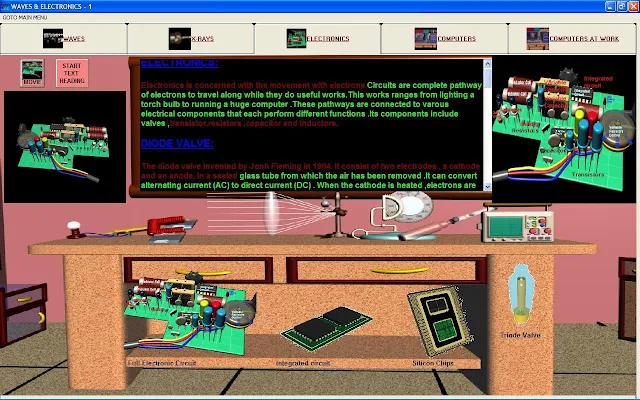 |
| Periodic Table With Elements Pictures |
Periodic table:
Is a tabular display of the chemical elements, organized on the basis of their properties. Elements are presented in increasing atomic number. While rectangular in general outline, gaps are included in the rows or periods to keep elements with similar properties together, such as the halogens and the noble gases, in columns or groups, forming distinct rectangular areas or blocks. Because the periodic table accurately predicts the properties of various elements and the relations between properties, its use is widespread within chemistry, providing a useful framework for analysing chemical behavior, as well as in other sciences.
Although precursors exist, the current table is generally credited to Dmitri Mendeleev, who developed it in 1869 to illustrate periodic trends in the properties of the then-known elements; the layout has been refined and extended as new elements have been discovered and new theoretical models developed to explain chemical behavior. Mendeleev's presentation also predicted some properties of then-unknown elements expected to fill gaps in his arrangement; these predictions were proved correct when those elements were discovered and found to have properties close to the predictions.


The Modern table is generally credited to Dmitri Mendeleev, who developed it in 1869 to illustrate periodic trends in the properties of the then-known elements; the layout has been refined and extended as new elements have been discovered and new theoretical models developed to explain chemical behavior. Mendeleev's presentation also predicted some properties of then-unknown elements expected to fill gaps in his arrangement; these predictions were proved correct when those elements were discovered and found to have properties close to the predictions.
 |
| Dmitri Mendeleev revolutionized our understanding of the properties of atoms and created a table that probably embellishes every chemistry classroom in the world. |
Mendeleev's table:
Mendeleev's 1869 periodic table; note that his arrangement presents the periods vertically, and the groups horizontally.Russian chemistry professor Dmitri Ivanovich Mendeleev and German chemist Julius Lothar Meyer independently published their periodic tables in 1869 and 1870, respectively. They both constructed their tables in a similar manner: By listing the elements in a row or column in order of atomic weight and starting a new row or column when the characteristics of the elements began to repeat. The success of Mendeleev's table came from two decisions he made: The first was to leave gaps in the table when it seemed that the corresponding element had not yet been discovered.Mendeleev was not the first chemist to do so, but he was the first to be recognized as using the trends in his periodic table to predict the properties of those missing elements, such as gallium and germanium. The second decision was to occasionally ignore the order suggested by the atomic weights and switch adjacent elements, such as cobalt and nickel, to better classify them into chemical families. With the development of theories of atomic structure, it became apparent that Mendeleev had listed the elements in order of increasing atomic number.
General properties Elements in Periodic Table:
Although Mendeleev had made a crucial breakthrough, he made little further progress. With the benefit of hindsight, we know that Mendeleev's periodic table was underpinned by false reasoning. Mendeleev believed, incorrectly, that chemical properties were determined by atomic weight. Of course, this was perfectly reasonable when we consider scientific knowledge in 1869.
In 1869 the electron itself had not been discovered - that happened 27 years later, in 1896. In fact, it took 44 years for the correct explanation of the regular patterns in Mendeleev's periodic table to be found.
The explanation came in 1913 from Henry Moseley, who fired electrons at atoms, resulting in the emission of x-rays. Moseley found that each element he studied emitted x-rays at a unique frequency.
 |
| English physicist Henry Moseley, who arranged the Periodic Table |
 |
| Moseley's Periodic Law |
When he looked at the frequencies emitted by a series of elements, he found a pattern that was best explained if the positive charge in the nucleus increased by exactly one unit from element to element.
In other words, Moseley had found that elements are different from one another because their atoms have different numbers of protons. He discovered that elements' positions in the periodic table are better predicted by their atomic numbers than their atomic weights. (An element's atomic number is equal to the number of protons, and hence electrons, in one of its atoms.)
Moseley's discovery cleared up the cobalt-nickel and argon-potassium problems.
Considering the argon-potassium problem, it was known that argon has a higher atomic weight than potassium. According to Mendeleev's reasoning, argon should therefore be placed after potassium in the periodic table. But, doing this made no sense in terms of chemical properties.
39.1
K
~ ~
39.9
Ar
~ ~
40.1
Ca
Moseley's work showed that argon's atomic number is 18 and potassium's is 19. Therefore argon should be placed before potassium in a periodic table based on atomic numbers. Chemists around the world breathed a collective sigh of relief, because this agreed with the observed chemical properties of these elements.
18
Ar
~ ~
19
K
~ ~
20
Ca
Moseley also emulated Mendeleev's achievement of discovering new elements on paper, finding four atomic numbers with no matching elements. He predicted the existence of elements with atomic numbers 43, 61, 72, and 75. These elements were indeed discovered; we now call them technetium, promethium, hafnium and rhenium.
1) We also now know that an element's chemistry is determined by the way its electrons are arranged - its electron configuration.
Electrons in atoms can be pictured as occupying layers or shells surrounding the atomic nucleus. This is shown in the diagram of a lithium atom on the left side of this page. We picture electrons as little planets whizzing around a sun-like nucleus, which is where the protons and neutrons are located. This is called a Bohr representation of an atom. This is actually an approximation, but it's a good starting point for understanding the chemical properties of the elements.
2) If we exclude the transition metal elements, we can say that atoms which occupy the same group of the periodic table have the same number of outer electrons. For example, all of the elements in Group 2, shown left, have two outer electrons. These outer electrons are called valence electrons. It is the valence electrons which cause chemical reactivity.
3) All of the elements in Group 1 have one valence electron; Group 2, two valence electrons; Group 13, three valence electrons; Group 14, four valence electrons; Group 15, five valence electrons; Group 16, six valence electrons; Group 17, seven valence electrons; and Group 18, eight valence electrons, except for helium, which has two.
4) Group 18 is the noble gas group, a group of unreactive elements. The reluctance of the noble gases to react chemically is the key that unlocks our understanding of why other elements do react. Unreactive Species: If an atom has the electron configuration of a noble gas it will be chemically unreactive, or only react with difficulty. Reactive Species: If an atom does not have the same electron configuration as a noble gas, it will tend to react in order to achieve this.
The noble gases are unreactive, because their outer electron shells are full. A full shell of outer electrons is a particularly stable arrangement. This means that noble gas atoms neither gain nor lose electrons easily; they react with other atoms with great difficulty, or not at all. Other atoms lose electrons, gain electrons or share electrons to achieve the same electron configuration as a noble gas - in doing so, they form chemical bonds, and make new substances.
A Sodium Atom Reacts with a Chlorine Atom to Make Sodium Chloride .All ions are either positively or negatively charged. Since our sodium atom has lost a negatively charged electron, it becomes a positively charged sodium ion: Na+. This sodium ion, with one electron fewer than the sodium atom, has the same electron configuration as the noble gas neon and is chemically stable.
The chlorine atom, which starts with seven valence electrons, gains a single electron and becomes a negatively charged chlorine ion: Cl-. This ion has the same electron configuration as the noble gas argon, and therefore this ion is chemically stable too.The positively charged sodium ion and negatively charged chlorine ion attract one another electrostatically, forming a stable chemical compound, sodium chloride. These electrostatic bonds are called ionic bonds.
For the transition metals the situation is a little more complicated than those described above, because electrons from the lower shells in transition metal atoms can become valence electrons. This is why, for example, we can get different types of copper ions, Cu+ and Cu2+, and iron ions, Fe2+ and Fe3+.
The number of valence electrons in atoms is the basis of the regular patterns observed by Mendeleev in 1869, patterns which ultimately have given us our modern periodic table.
 |
| Some Important Characteristics Periodic Table |











































.jpg)





























 Online Movies
Online Movies